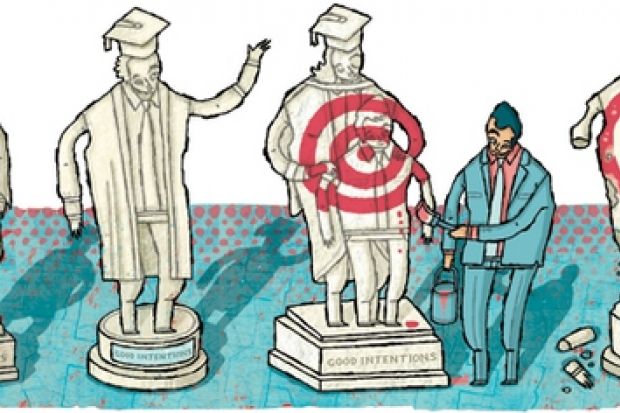Why is it that perfectly sensible and desirable public intentions become cumbersome bureaucratic impositions when they are adopted as official policy goals?
Take three live examples in higher education: encouraging more young people from disadvantaged backgrounds to access higher education; seeking greater economic and social benefits from publicly funded academic research; and improving the professional and management skills of the UK's workforce through work-based university study.
Few people would argue with the merits of these examples, but for each laudable aim, the related policy interventions have generated a plethora of performance targets, reporting prescriptions and regulatory impositions that have created burdensome mini-industries of their own - often with minimal effect on the results they purport to promote. We call this phenomenon "the bureaucratisation of good intentions". It illustrates a worrying disconnection between policy and reality.
The nub of the problem is the confusion of outputs and outcomes from the higher education system. The good intentions cited above are all outcomes from complex individual and corporate behaviours across overlapping ecosystems (such as families, schools, employers and different parts of the government, as well as higher education institutions). It is a dangerous misconception to treat such outcomes as if they were outputs from planned and controllable delivery processes.
This misconception is dangerous for three reasons. First, it superimposes homogeneous solutions on the diversity of higher education institutions and their necessarily different approaches to meeting their public commitments. We see this effect among institutions fixated on improving their league table benchmarks, even when the criteria involved are detrimental to their strategic interests.
Second, it flouts Goodhart's Law, which shows that adopting proxy measures of outcomes as policy targets invalidates their usefulness for the original intention. This is because selecting arbitrary indicators of complex outcomes encourages game-playing to manipulate performance against those measures - such as "managing" research citations, or "influencing" National Student Survey responses.
Finally, it leads to unintended consequences, such as discrimination against well-qualified students from the "wrong" (middle-class) background in favour of politically prioritised intakes, or kettling students in overcrowded lecture halls to satisfy contact-hour targets.
The lesson here for policymakers is that you can't foster qualitative outcomes by imposing quantitative output targets. It is not realistic for the government to express fuzzy goals in terms of simplistic targets - and then berate universities to "make it so". Management-by-numbers has been tried and found wanting: what we need are smarter policies that recognise the complexities of securing public benefits from the higher education system.
If the government followed its declared belief in the transformative potential of "Big Society" customer power, it would focus on shaping the private behaviours that generate public outcomes. A more balanced approach would recognise that the benefits of higher education, both private and public, depend on a convergence of interests between the academy and its various client groups. Indeed, without strong individual, social and business demand for engagement with the sector, pressures on universities to deliver social and economic change are doomed to disappointment.
The constraints on wider participation probably lie more in the families, schools and heads of 14-year-old boys than in universities, just as patchy take-up of part-time and work-based higher education programmes often reflects limited interest among employers and employees. Improved policy outcomes depend on the translation of public needs into private demands as a prerequisite for the success of university responses.
There may be an analogy here with environmental policy (recycling, carbon reduction, sustainable energy and so on). Here, there is growing recognition that targets alone are impotent: the big changes we have seen have come from marketising public goals to create economic interest in the outcomes sought, for example through the introduction of carbon trading and targeted tax breaks.
Governments of all hues have a long tradition of promoting supply-side solutions to demand-based problems, no less in higher education than in other sectors. As long as universities depended on public funding, they could be relied upon to do the government's bidding, whether or not the policy results justified the effort. That power has been emasculated by the new economics of higher education, and universities are now compelled to respond to the demands of competitive and essentially private global markets. This creates a paradox for policymakers and institutions alike - how can private markets generate public benefits?
Register to continue
Why register?
- Registration is free and only takes a moment
- Once registered, you can read 3 articles a month
- Sign up for our newsletter
Subscribe
Or subscribe for unlimited access to:
- Unlimited access to news, views, insights & reviews
- Digital editions
- Digital access to THE’s university and college rankings analysis
Already registered or a current subscriber? Login
